最新交错并联式双管正激变换器及其控制电路毕业
双管正激变换器交错并联的方法比较

双管正激变换器交错并联的方法比较摘要:从开关器件的电压应力来看,双管正激变换器较一般的正激变换器有更多的优点。
本文提出了两种双正激变换器交错并联的方法,分析了两种电路的工作状态,比较了两种电路中输出滤波电感和电容中的电流脉动,对比了两种电路中各半导体器件的电流电压应力。
最后通过仿真和实验证明了分析和比较的正确性。
关键词:双管正激变换器移相并联开关应力Comparison of Interleaving Methods of Two— transistor Forward Converter Abstract:Two methods of interleaving two— transistor forward converters are presented in this paper・ Firstly, the operation stages are analyzed・ Then the ripple currents in filter inductors and output capactiors in toth methods are discussed and compared・ After that , the current and voltage stresses of divices are investigated and compared as wel1. Finally, simulation and experiments are performed to verify the analysis and comparision. Keywords:Two— transistor forward converter Interleaving of converters Switching stress1引言双管正激变换器较单管正激变换器有很多优点,特别是在电压应力方面,因为变换器中每个功率器件只需承受电源电压,而在单管正激变换器中则要承受两倍的电源电压。
一种新型交错并联型buck变换器
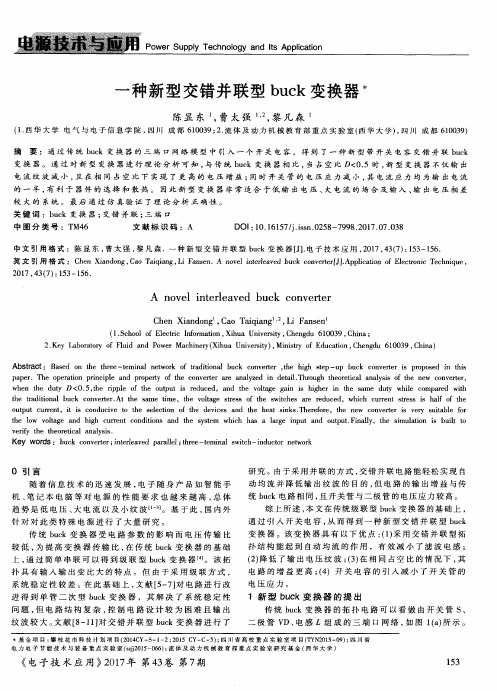
种新 型交错并联 型 b u c k变换器
陈显 东 , 曹 太 强 , 黎 凡 森
( 1 . 西 华 大 学 电气 与 电子 信 息 学 院 , 四川 成 都 6 1 0 0 3 9; 2 . 流 体及 动 力 机 械 教育 部 重 点 实验 室 ( 西 华 大 学) , 四川 成 都 6 1 0 0 3 9 ) 摘 要 :通 过 传 统 b u c k变 换 器 的 三 端 口 网 络 模 型 中 引 入 一 个 开 关 电容 ,得 到 了 一 种 新 型 带 开 关 电 容 交 错 并 联 b u c k
的一半 , 有 利 于 器 件 的 选 择 和 散 热 。 因 此 新 型 变换 器 非 常 适 合 于 低 输 出 电压 、 大 电流 的场合 及输 入 、 输 出 电 压 相 差
较 大 的 系 统 。 最 后 通 过 仿 真 验 证 了理 论 分 析 正 确 性 。
关 键 词 :b u c k变 换 器 ; 交错 并联 ; 三端c r 中 图 分 类 号1 0 . 1 6 1 5 7 / i . i s s n . 0 2 5 8 — 7 9 9 8 . 2 0 1 7 . 0 7 . 0 3 8
中 文 引 用 格 式 :陈 显 东 , 曹太 强 , 黎 凡 森 .一 种 新 型 交 错 并 联 型 b u c k变 换 器 【 J 】 . 电子 技 术 应 用 , 2 0 1 7, 4 3 ( 7 ) : 1 5 3 — 1 5 6 .
英 文 引 用 格 式 :C h e n X i a n d o n g , C a o T a i q i a n g , L i F a n s e n . A u o v e l i n t e r l e a v e d b u c k c o n v e r t e r [ J ] . A p p l i c a t i o n o f E l e c t r o n i c T e c h n i q u e , 2 0 1 7, 4 3 ( 7 ) : 1 5 3 — 1 5 6 .
基于TL494的交错并联双管正激变换器的研制
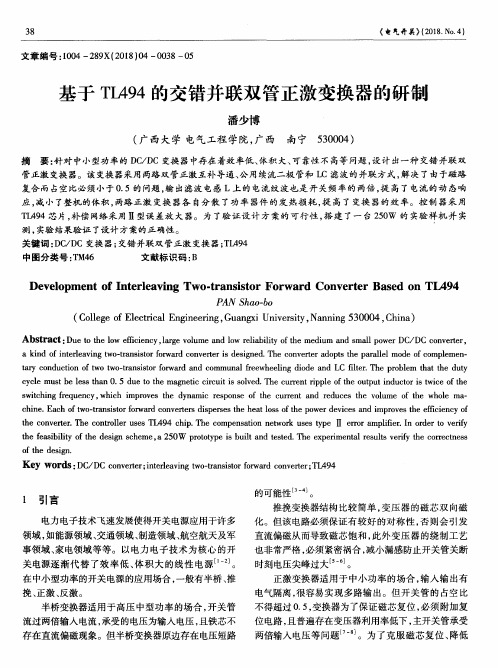
正激 变换 器适 用 于 中小 功 率 的 场合 ,输 入 输 出有 电气 隔离 ,很容 易 实现 多 路 输 出 。但 开关 管 的 占空 比 不得 超过 0.5,变换 器 为了保 证 磁 芯复 位 ,必 须 附加 复 位 电路 ,且 普遍 存在 变压 器利 用率低 下 ,主开关 管承 受 两倍输入 电压等 问题。。卜引。为 了克服磁芯复位、降低
管正激 变换 器 。该 变换 器采 用 两路 双 管正激 互补 导通 、公 用续流 二极 管和 Lc滤 波的 并联 方 式 ,解决 了由 于磁 路
复合 而 占空 比必须 小于 0.5的 问题 ,输 出滤 波 电感 L上 的 电流 纹 波也 是 开 关频 率的 两 倍 ,提 高 了电流 的 动 态 响
38
文章 编号 :1004—289X(2018 J04—0038—05
《电 气开 关 》(2018.No.4)
基于 TIA94的交错并联双 管正激变换器的研制
潘少博 (广西大学 电气工程 学院 ,广西 南宁 5பைடு நூலகம்0004)
摘 要 :针对中小型功率的 DC/DC变换器中存在着效率低 、体积大、可靠性不高等 问题 ,设计 出一种交错并联 双
1 引 言
电力 电子技术 飞 速发展 使得 开关 电源应 用于 许多 领 域 ,如能源 领域 、交 通领域 、制 造领域 、航 空航天 及军 事 领域 、家 电领域 等 等 。 以 电力 电 子技 术 为 核 心 的 开 关 电源逐渐代替 了效率低 、体积大 的线性 电源 I2 J。 在中小型功率的开关电源的应用场合 ,一般有半桥 、推 挽 、正 激 、反 激 。
基于TL494的交错并联双管正激变换器的研制

对工程施工提出合理化建议工程施工合理化建议篇一所谓“工程”,是科学的某种应用,通过这一应用,使自然界的物质和能源的特性能够通过各种结构、机器、产品、系统和过程,是以最短的时间和精而少的人力做出高效、可靠且对人类有用的东西。
顾名思义,在一定的资源条件下实现工程项目的技术经济效益,达到施工效益与经济效益双赢才是做工程的最终目的。
为了达到这个目的,工程管理的合理化设计在整个工程项目中占据了举足轻重的地位:一、在施工过程中,工程技术人员缺乏技术理论基础和具体施工经验的情况很严重,技术指导书只是对技术范围空洞叙述,而未对具体工程的特点进行有针对性的规范和讲解,没有起到指导施工作用。
针对这种现状,公司必须培养工程技术人员用“心”做工程,责任心居首。
并树立“现场为主,理论为辅”的工程理念。
对于工程技术人员的培训必须全面,特殊工程必须有针对性。
二、古语云:粮草未到,兵马先行。
工程技术人员在前线奋斗,后勤人员的工作就是及时的为他们输送“弹药”。
在工作中我发现了不少技术人员干着干着没钱用或者干着干着没设备装的情况。
这说明前后方的衔接与沟通不够,应该加强力度。
不能感觉自己不在其位,则不需要谋其政。
三、安全问题永远是我们总是挂在嘴边,又不去重视的一个问题。
公司政策下来了,却很少有人实施。
这种行为是把自己的生命当儿戏的行为。
安全第一的思想必须深深的在工程技术人员的脑海里面扎根。
对于不听指挥的,该罚就罚绝不手软。
四、公司员工对公司设备所存在的缺陷以及工程遗留问题反馈的信息过少。
电子设备无论是硬件还是软件的完善过程都是一个不断发现缺陷不断补充自己的过程,软件工程师编写出来的程序,应用的最多的是我们的工程技术人员,最能发现美中不足的也是我们的工程技术人员,所以这就要求我们的工程技术人员要把这些信息反馈给公司,让我们的产品更趋于完善。
不存在问题的工程是假的,我们必须正视存在的问题,不能逃避,不能有投机取巧的心里。
公司需要建立完善的信息反馈体系,发现问题,想办法解决问题,这才会使蓝盾公司不断强大。
一种新型的并—串型双管正激组合变换器
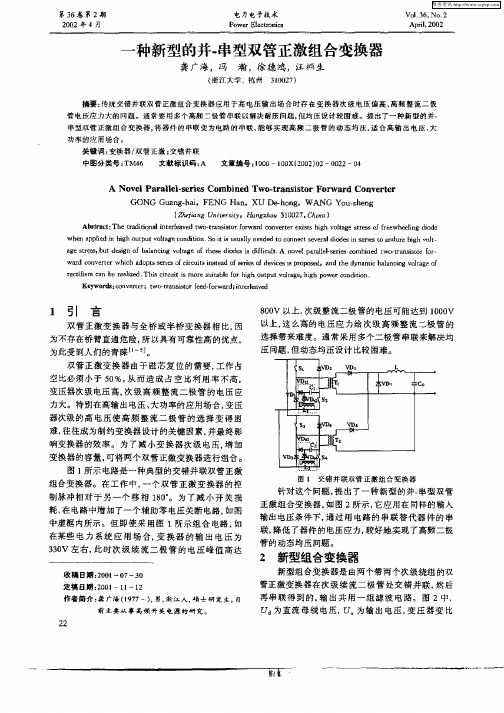
第3 6卷 第 2期
20 0 2年 4 月
电 力电 子技 术
P we lcrnc o r E eto is
Vo. 6 No 2 13 . .
Aprl20 i. 02
一
种新型的并. 串型双管正激组合变换器
龚 广海 ,冯 瀚 ,徐德 鸿 ,汪 梗 生
302) 1 07 ( 江 大学 .杭 州 浙
摘要 : 传统交 错并联双 管正激组合变换器应用于高 电压输 出场合 时存在变 换器敬级 电压偏 高、 频整流二极 高 管 电压应力大的问题。通常要用多个高频二极管串联 解决 耐压问题, 但均压设计较困难。提 出了一种 新型的并. 串型双管正激组合变换器, 将器 件的串联变 为电路 的串联, 能够实现高频 二极管 的动 态均压 , 适合 高输 出电压、 大
双管 正 激 变换 器 由于 磁 芯 复位 的 需 要, 作 占 工
以上 , 这么高 的电 压 带来难度 。通 常采 用多个 二极管 串 联来解决 均 压 问题 , 但动态均 压设 计 比较 困难 。
空 比必须 小 于 5 %, 而造 成 占 空 比利 用 率不 高 . 0 从
wa d c n e ̄ r wh c d p i ic is n t a fsre e l o o e .a d t e d n mi Ea cn  ̄ t g f r o v ie ih a o t s e o cr u t i se d o e i o d v e i r p s d n h y a c hd n ig k s e sf r sf s e s ̄ a eo
GONG a g h i ENG Ha ,XU - o g Gu n - a .F n De h n .W ANG u s e g Yo - h n 【 hj n n vri -H n z o 1 0 7 C ia Z ci g t ies y ' a a t a g h u 3 0 2 . hn J
并-串型双管正激组合变换器-◆电源开发网◆ _ 学习电源技术知识
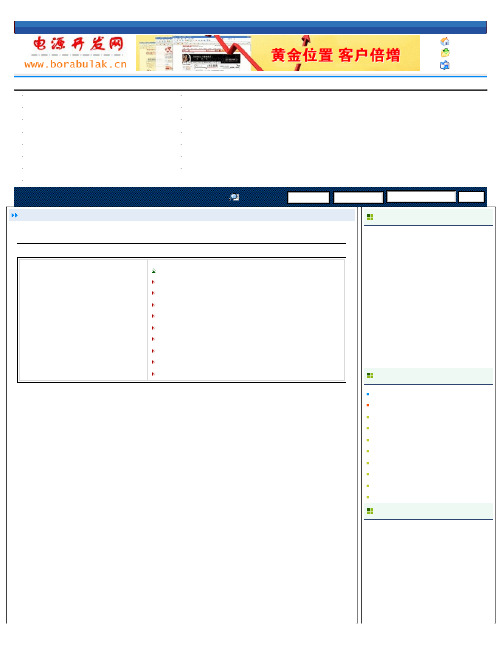
| 网站首页 | 电源技术 | 电源资料 |电源电路 | 电源论坛 | 电源人才 | 电源供求 | 留言本站 |专 题 栏 目● 开关电源设计● 逆变电源设计● UPS电源设计● EPS电源设计● PC电源设计● 变频器设计● 充电电源● 通信电源● 模块电源● 特种电源更多专题热 门 文 章电源开发资源----可免费…一种用单片机制作的高频…计算机ATX电源原理及检修…基于UC3842的单端反激式…高效能低电压Power MOSF…气体放电管在浪涌抑制电…多路输出开关电源的设计…开关电源中的电流型控制…基于单片机的智能稳压电…脉冲激光电源的设计与研…热 门 下 载设为首页收藏本站繁體中文|电源技术首页|新手入门|设计进阶|电源大全|程序设计|设计工具|行业动态|● ·【中文手册网】-免费下载中文Datasheet● · 可免费申请的电子类杂志列表● · 中文数据手册网-免费下载中文Datasheet ● · 全站此处文字广告招租,QQ:225542875● ·电源书:开关电源入门● · 卓越亚马逊,电源专业书籍七折起● ·电源书:开关电源设计(第2版)● ·电源书:精通开关电源设计● · PowerEsim--免费在线开关电源设计工具 ● · 全站此处文字广告招租,QQ:225542875● · 全站此处文字广告招租,QQ:225542875 ● ·电源电路大全,免费下载● · 全站此处文字广告招租,QQ:225542875 ● · 全站此处文字广告招租,QQ:225542875● · 全站此处文字广告招租,QQ:225542875[ 2011年6月18日 星期六 ] 文章搜索:导航: 电源开发网 >> 电源技术 >> 设计进阶 >> 电源知识 >> 正文并-串型双管正激组合变换器 2008-11-26 电源开发网★★★电源开发资源----可免费申请的专业杂志列表开关电源的冲击电流控制方法开关电源稳定性设计散热器镶齿及焊接技术在大功率电源热设计中…一种用单片机制作的高频正弦波逆变器大功率UPS中DSP与单片机的串行通讯设计一种2KW高频开关电源的设计全桥驱动器芯片UBA2032T/UBA2032TS基于TOPSwitch的反激变流器反馈电路的优化设…数控直流电流源的设计与实现1.组合变换器 传统交错并联双管正激组合变换器应用于高电压输出场合时存在变换器次级电压偏高、高频整流二极管电压应力大的问题。
交错并联峰值电流控制双管正激变换器的设计

中图分类号 : M4 T 6
文献标识码 : A
文章编号: 6 2 5 5 2 1 0 — 0 3 0 1 7 — 4 X( O 2)3 0 3 — 2
双 管 正激 变 换 器开关 管承 受 电压 应力 低 ,输 入
主 电路 由两 套 不 同的 双 管正 激 变换 器 构 成 , 在
直流 电源不会短路 , 可靠性高 , 中小功率场合得到 在 广泛应用。但双管正激变换器的变压器工作在第一 象 限, 严重影响变换器的功率容量输出。为了提高输 出功率 , 采用交错并联控制 的方法 , 以提高变换器 可 的输 出功率 , 同时减小输 出电流纹波 , 降低滤波器体 积, 还可以应用到大电流输出场合 。 本文以双管正激电路 为主电路 ,采用交错并联 控制方式【 以 U 34 芯片为控制核心 , ” , C 86 采用峰值电 流反 馈 的控 制模 式 ,研 制一 台 3k 的 D /C变 换 w CD 器 装 置 , 给 出 了相 应 的实 验结果 。 并
。 ‘ f . ¨… ’ … 】
1 ‘
0
t I
J ‘
7 。 。
~ 。
… ●
电压调节器设计步骤如下 : () 1 首先确定电压开环传递函数的截止频率 , 根
据 电路 平 均 法 建模 的要求 , 一般 取 1 / 6—11 关频 /0开
3 4
I 一 、 -
2 系统的实现
图 1 主电路拓扑结构图
收 稿 日期 :0 1 1— 1 2 1- 2 0
双管 正激样 机 主要技 术指标 如 下 :
作者简介 : 嵘( 9 8 ) 女 , 丘 17 一 , 广东广州人 , 师 , 讲 硕士学位, 研究方 向为 电力电子技 术与应用 。 33
具有ZVS的DCDC升压变换器分析与设计毕业设计

具有ZVS的DCDC升压变换器分析与设计毕业设计摘要随着当今社会主要能源的日益枯竭,太阳能光伏发电越来越受到重视。
其良好的优越性对于经济生态环境和社会稳定发展有着重要意义。
随着电力电子技术高频化的发展趋势,升压DC-DC变换器在两极式光伏发电系统中的应用得到了不断的发展和完善。
对比几种基本的升压变换器发现,正激升压变换器更为可靠。
同时针对传统的正激变换器的典型缺陷,对其进行了拓扑改进,加入“交错并联”和LCD 缓冲网络两种特殊结构,并运用新型移相控制技术,提出了具有缓冲电路的ZVS 交错并联双管正激升压变换器。
本文首先对其结构中的LCD无损缓冲网络、新型移相控制技术进行分析,详细研究了十二个理论工作模态,然后设计了以TMS320F2812为控制中心的硬件实验样机平台,完成了主电路参数设计、器件选型、外围电路分析与设计。
最后通过PSpice软件仿真和实验样机硬件调试双重验证了文中改进型升压变换器理论分析的正确性,也证明了具有缓冲电路的ZVS交错并联双管正激升压变换器的可行性与可靠性。
关键词:光伏发电;升压变换器;零电压;LCD缓冲网络;移相控制AbstractIn today's society, solar photovoltaic power generation is receiving more and more attention as the major energy is exhausting. Its advantages make significant contribution to ecological environment and social stability. With high frequency trend of the development of power electronics technology, bipolar boost DC-DC converter in the photovoltaic power generation system has constantly development and improvement.Compared with several basic boost converter, forward boost converter is more reliable. Simultaneously, for the typical defects of the traditional boost converter, its topology is improved. Two special structures of “staggered parallel” and LCD snubber network are added and new phase-shifting control technology is applied. Therefore, a staggered-parallel dual switch of boost converter with snubber circuit for ZVS is put forward.First this article analyzed the structure of LCD lossless snubber network and new phase-shifting technology. And twelve theoretical operating modals is studied in detail. Then it designed a prototype hardware platform based on TMS320F2812. Parameter design of main circuit, components selection, and peripheral circuit’s analysis and design is accomplished. Finally, Pspice simulation and experiment prototype hardware debugging double verified the correctness of the theoretical analysis of the modified boost converter. The feasibility and reliability of the staggered-parallel dual switch of boost converter with snubber circuit for ZVS are proved.Keywords: photovoltaic power generation, zero-voltage-switch, LCD snubber network, phase-shifting, boost converter目录摘要 (I)Abstract (II)第1章绪论 (1)1.1课题来源及研究的目的和意义 (1)1.2双管正激变换器国内外研究现状 (3)1.3主要研究内容与方案 (5)1.3.1改进型交错并联双管正激升压变换器主拓扑结构的确定51.3.2具有ZVS升压变换器主电路PSpice仿真验证 (6)1.3.3具有ZVS升压变换器总体结构设计 (6)1.3.4制作实验样机并完成相关功能验证 (7)第2章具有ZVS升压变换器工作原理 (8)2.1主拓扑结构的确定 (8)2.2工作模态分析 (9)2.3本章小结 (22)第3章具有ZVS升压变换器硬件电路的设计 (23)3.1实验样机整体系统设计 (23)3.2辅助电路的设计 (23)3.2.1驱动电路的设计 (23)3.2.2保护电路的设计 (24)3.2.3保护执行回路设计 (25)3.3主电路的设计 (26)3.3.1高频变压器的设计 (26)3.3.2功率开关管及二极管的选择 (28)3.3.3其它元件的选取 (29)3.4控制电路设计 (29)3.5闭环控制设计 (29)3.6本章小结 (30)第4章软件仿真与参数校正 (32)4.1驱动信号模拟 (32)4.2主电路参数选定 (32)4.2.1变压器变比设定 (32)4.2.2功率开关管及二极管参数设定 (32)4.3主电路仿真 (32)4.3.1额定负载下的仿真波形 (33)4.3.2 ZVS的在变换器中的实现 (38)4.4本章小结 (39)第5章硬件制作与调试 (40)5.1实验样机的搭建 (40)5.2 实验波形分析 (41)5.3软开关的实现 (42)5.4变换器性能指标测试 (42)5.4.1电压调整率测试 (42)5.4.2输出电压纹波测试 (42)5.4.3负载调整率测试 (43)5.4.4效率测试 (43)5.5本章小结 (44)结论 (45)参考文献 (47)致谢 (49)哈尔滨工业大学本科毕业设计(论文)第1章绪论1.1课题来源及研究的目的和意义随着人类社会中煤、石油、天然气等主要能源的急剧消耗,人们越来越重视太阳能、风能等绿色能源的开发和利用。
零电流零电压开关交错并联双管正激变换器的研究
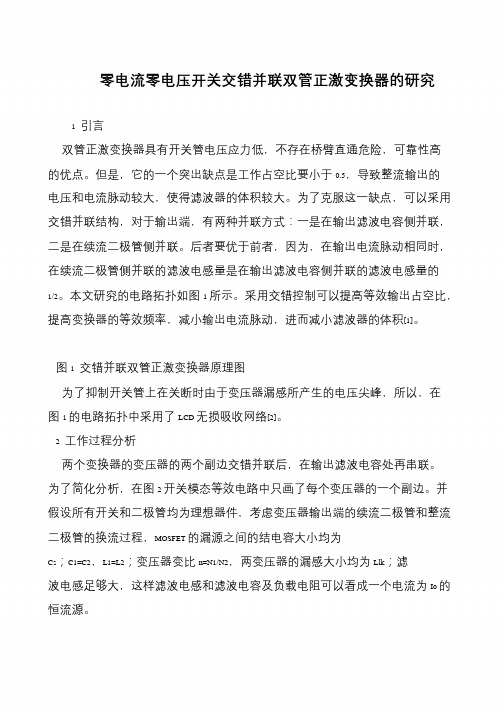
零电流零电压开关交错并联双管正激变换器的研究
1 引言
双管正激变换器具有开关管电压应力低,不存在桥臂直通危险,可靠性高
的优点。
但是,它的一个突出缺点是工作占空比要小于0.5,导致整流输出的
电压和电流脉动较大,使得滤波器的体积较大。
为了克服这一缺点,可以采用
交错并联结构,对于输出端,有两种并联方式:一是在输出滤波电容侧并联,
二是在续流二极管侧并联。
后者要优于前者,因为,在输出电流脉动相同时,
在续流二极管侧并联的滤波电感量是在输出滤波电容侧并联的滤波电感量的
1/2。
本文研究的电路拓扑如图1 所示。
采用交错控制可以提高等效输出占空比,提高变换器的等效频率,减小输出电流脉动,进而减小滤波器的体积[1]。
图1 交错并联双管正激变换器原理图
为了抑制开关管上在关断时由于变压器漏感所产生的电压尖峰,所以,在
图1 的电路拓扑中采用了LCD 无损吸收网络[2]。
2 工作过程分析
两个变换器的变压器的两个副边交错并联后,在输出滤波电容处再串联。
为了简化分析,在图2 开关模态等效电路中只画了每个变压器的一个副边。
并
假设所有开关和二极管均为理想器件,考虑变压器输出端的续流二极管和整流
二极管的换流过程,MOSFET 的漏源之间的结电容大小均为
Cs;C1=C2,L1=L2;变压器变比n=N1/N2,两变压器的漏感大小均为Llk;滤波电感足够大,这样滤波电感和滤波电容及负载电阻可以看成一个电流为Io 的恒流源。
交错并联峰值电流控制双管正激变换器的设计

交错并联峰值电流控制双管正激变换器的设计一、什么是交错并联峰值电流控制双管正激变换器?大家好,今天咱们要聊一聊一个听起来挺高大上的电力电子话题——交错并联峰值电流控制双管正激变换器。
哇,听着是不是有点晦涩难懂?别担心,咱们慢慢捋清楚。
其实它的核心也就是一个电源转换器,作用就是把一种电压转换成另一种电压,比如将高电压的电池电量转换成适合你手机、电脑的电压。
至于“交错并联”和“双管正激”这俩名词嘛,乍一听确实让人晕乎乎的,不过讲究的是“高效”——换句话说,如何让转换过程少点浪费,多点稳定。
所谓“双管正激”,也就是它使用了两个开关管来调节电流,帮助电流在转换过程中更加平稳。
正激变换器嘛,它的工作原理其实挺简单,就是让电流流过一个变压器,进行能量转换。
在此基础上,我们再通过“交错并联”的方式,避免过大的电流冲击,减少过多的干扰,提升转换效率。
二、交错并联的好处?想象一下,两个赛车在赛道上并肩飞驰,谁能先到终点,谁就赢得比赛。
赛车各自有各自的动力系统,虽然都在同一个赛道上,但是他们通过交错的方式,互相配合,能够达到更高效、更稳定的效果。
你看,这是不是跟咱们的交错并联峰值电流控制变换器有点类似呢?交错并联的目的就是让电流流动得更加平衡,避免电流过大的时候一个管子“撑不住”。
要是只用一个管子,负担就全都压在它身上,坏了很容易,不仅热量大,效率也低。
把管子交错并联起来,每个管子就能分担一部分工作,互相“帮衬”,就像兄弟俩一起扛东西,轻松不少。
这么一来,电流就不会产生峰值,电压也更加稳定,整个变换器就像是跑得稳、吃得香的赛车,工作起来顺风顺水,没啥问题。
三、峰值电流控制的妙用咱们接下来聊聊“峰值电流控制”。
有时候啊,电流像个调皮的小孩,跑得太快,或者跑得太猛,搞得设备都跟着抖。
为了不让电流过猛,影响整个电路的运行,峰值电流控制就派上用场了。
简单来说,就是在电流达到一定峰值的时候,通过控制开关的开启和关闭,来限制电流的过快增长。
- 1、下载文档前请自行甄别文档内容的完整性,平台不提供额外的编辑、内容补充、找答案等附加服务。
- 2、"仅部分预览"的文档,不可在线预览部分如存在完整性等问题,可反馈申请退款(可完整预览的文档不适用该条件!)。
- 3、如文档侵犯您的权益,请联系客服反馈,我们会尽快为您处理(人工客服工作时间:9:00-18:30)。
交错并联式双管正激变换器及其控制电路毕业摘要本文主要研究了交错并联式双管正激变换器及其控制电路。
相比于其他隔离式DC/DC变换器,交错并联结构的双管正激变换器有自动实现励磁能量的回馈,结构简洁等优点。
同时,其主功率管只需承受电源电压,从而选择面更广。
此外,其并联结构缩小了输出滤波电感的体积,降低了器件的应力,从而进一步减小了损耗。
在控制电路的设计方面,考虑到电源输出电压范围的可控性,本文采用电压反馈控制方式,选用UC3825型脉宽调制器。
本文列举了DC/DC变换的各种拓扑,比较了四种PWM控制模式,分析了交错并联式双管正激变换器的工作原理及其工作过程,详细推导并建立了带有电压反馈控制的双管正激变换电路的小信号模型,设计了补偿网络,给出了主电路和控制电路的工程计算。
最后,对系统进行频域、时域仿真,并给出相关分析。
关键词:双管正激变换器、电压反馈控制、小信号模型、补偿网络、仿真AbstractThis paper studies the parallel dual interleaved forward converter and its control circuit. Different to other isolated DC/DC converters, the parallel dual interleaved forward converter can feedback excitation energy automatically, also, simple structure is the one of the system’s advantages. Meanwhile, the power switches only need to work just under the main power voltage, which makes the designers have a wider range of choosing the power switches. In addition, the parallel structure reduces the volume of the output filter inductance, reducing the stress of the device, thereby, further reducing the loss. In the control circuit design, taking into account of the controllability of the range of the output voltage, we use voltage feedback control method, and chose the UC3825 voltage pulse width modulator. This article lists the DC/DC conversion of the various topologies, makes a comparison of the four PWM control modes, analyzes the parallel dual interleaved forward converter’s operating principle and working process, derives in detail and establish the small signal model, designs the compensation network, and carries out the main circuit’s and control circuit’s engineering calculation. Finally, this paper makes the system frequency and time domain simulation, and make some correlation analysis.Key words: dual forward converter, voltage feedback control, small signal model, compensation network, simulation目录摘要 (I)Abstract (I)目录 (II)第1章绪论 (1)1.1开关电源概述 (1)1.2本课题研究意义 (1)1.3隔离式DC/DC变换拓扑列举 (2)1.4反馈控制模式分类 (4)1.5本课题方案研究 (7)1.5.1功率电路选择 (7)1.5.2控制电路的选择 (8)1.6本文研究的主要内容 (8)1.7本章小结 (8)第2章功率电路状态分析及其参数设置 (9)2.1功率电路结构及其工作原理分析 (9)2.1.2电路结构分析 (9)2.1.2功率电路工作原理分析 (9)2.2主电路参数设计 (14)2.2.1技术指标 (14)2.2.2功率电路变压器设计 (15)2.3.3主功率开关管的选择 (19)2.3.4二极管的选择 (19)2.3.5输出滤波电感的选择 (20)2.3.6输出滤波电容的选择 (21)2.4本章小结 (21)第3章系统建模与控制电路的设计 (22)3.1功率电路建模 (22)3.1.1小信号模型的建立 (22)3.1.2标准型等效电路的建立 (25)3.2电压控制脉宽调制器建模与系统稳态传递函数的建立 (28)3.2.1电压控制型开关调节电路原理介绍 (28)3.2.2脉宽调制器的数学模型 (28)3.2.3电压控制系统原始回路稳态传递函数的建立 (29)3.2.4补偿网络的设计 (31)3.3控制电路结构 (34)3.3.1 UC3825外围电路 (34)3.3.2主功率管驱动电路 (36)3.3.3过流保护电路 (37)3.4本章小结 (38)第4章电路仿真 (39)4.1仿真软件简介 (39)4.2系统时域仿真 (40)4.2.1时域仿真电路及其波形 (40)4.2.2时域仿真分析 (44)4.3本章小结 (45)结论 (46)参考文献 (47)致谢 (50)附录 (1)第1章绪论1.1 开关电源概述随着电力电子技术的飞速发展,固态化静止型功率变换电源已经发展成为电力电子技术的三大应用领域之一(另两个是“运动控制”和“电力品质控制”)。
其中,开关类电源是技术含量较高的一大类产品。
它们的功率不断增大,已经从几十、上百瓦扩展到数百千瓦,继计算机、电视机中的应用而成功地跨入程控交换机、移动电话等通讯电源中,正在或即将为电镀、电解(化工电解和有色金属电解)行业提供“开关整流器”。
体现了效率高、体积小、重量轻、效益好等许多优点。
四十多年来,随着功率半导体器件品种的增加和性能的改善,以DC/DC(直流/直流)变换器为代表的开关电源主电路拓扑经历了“史前期”、“奠定期”和“成熟期”等几个阶段,演变成从理论到实践都十分完备的独立技术和独立产品产业,产生很大的社会经济效益。
这是几代人持续奋斗,许多人不断贡献所共同积累的结果。
如今,广泛应用于生产的各个领域的开关电源已具备以下几个突出优势:(1)效率高,开关稳压电源调整开关管的工作状态,在截止期间,开关管内无电流流经,因此不消耗功率,大大提高了电能使用效率,而传统使用的调整串连型稳压电源的晶体管一直工作在放大区,功耗大,效率低。
(2)开关管在开关状态,功率消耗小,不需要采用大功率散热装置。
这样,机内温升低,元器件不会因为长期工作在高温环境下而损坏,提高了整机的稳定性和可靠性。
(3)稳压范围较宽,适用于电网电压波动较大的地区。
(4)体积小。
开关电源可对电网输入的交流电直接进行整流,再由脉冲变压器获得各组相异的脉冲电压,省去了笨重的工频变压器,同时节省了大量漆包线和硅钢片,大大缩小了电源的体积,减轻了电源的重量。
(5)安全性高。
开关电源一般都具有自动保护功能,当稳压电路、高压电路或负载出现故障时,能自动切断电源,起可靠保护作用。
1.2 本课题研究意义依据开关电源的发展史及其应用领域,开关电源的主电路拓扑可分为两类:非隔离型和隔离型。
非隔离型是指在工作期间输入源和输出负载共用电流通路,具体有降压、升压、升降压、cuk、Sepic和Zeta型等。
隔离型是指其能量的转换依靠一个相互耦合的磁性元件(变压器)来实现的,而且从源到负载的耦合借助的是磁通而不是共同的电路,包括正激式、反激式、推挽式、半桥式、全桥式等。
由于非隔离式变换器工作时占空比较小,利用率较低。
与隔离式变换器相比,在相同频率下工作时,流经功率管的电流较大,开关应力较大,因此非隔离式变换器对元器件的损耗也较大。
因此,非隔离式变换器具有较大发展空间。
现代的一部分电子设备既要使用高压直流电又需要220V的额定交流电,对此采用的方法一般是先进行DC/AC逆变,得到220V交流电,需要高压直流电时再进行AC/DC整流,从而得到需要的直流电。
但另一部分的设备不需要交流电,只需单纯的直流电作为电源,例如安全防护报警装置、消防报警装置、事故照明等。
此时,电源的设计就可以采取绕过DC/AC逆变,而直接进行DC/DC 变换的方案。
现对两种方案进行比较,从电源效率来看:使用逆变器的方案,电路需要经过两级变换,从而电能也要损耗两次,电源的效率降低;而DC/DC 方案只要一级变换,损耗小。
此外,逆变器方案元器件较多,体积庞大;而DC/DC方案电路和驱动都较为简单,重量轻,体积小。
通过对比,在仅需直流电供电的设备中,DC/DC供电方案有其明显的优势。
本课题实现的就是12/264V 的DC/DC变换。
鉴于以上原因,本课题具有较高的研究价值。
1.3 隔离式DC/DC变换拓扑列举(1)正激式变换器如图1.3.1所示,输入输出电压隔离,易实现多路输出,变压器原边通过复位电路对磁芯进行磁复位,将变压器激磁时储存的能量回馈到输入端。
这种拓扑存在明显的不足:其一,变压器铁芯单向磁化,利用率低;其二,该电路主功率管需承受两倍的输入电压,介于此原因,它只能应用于低压输入电路。
其三,实际运用中,主功率管的占空比一般小于0.5;最后,添加去磁绕组原理固然简单,但这样做使变压器的结构趋于复杂,制造工艺水平的高低将会对电路性能产生一定影响。
U i图1.3.1 正激式变换器(2)反激式变换器如图1.3.2,反激变换器的变压器不同于一般电路的变压器,它实际上为耦合电感,起着输入输出隔离并储存能量的作用。
反激式变换器电成本低,可靠性高,驱动简单。
有以下缺点:首先,输出功率受到变压器储能的限制,只能用于小功率和消费电子设备。
